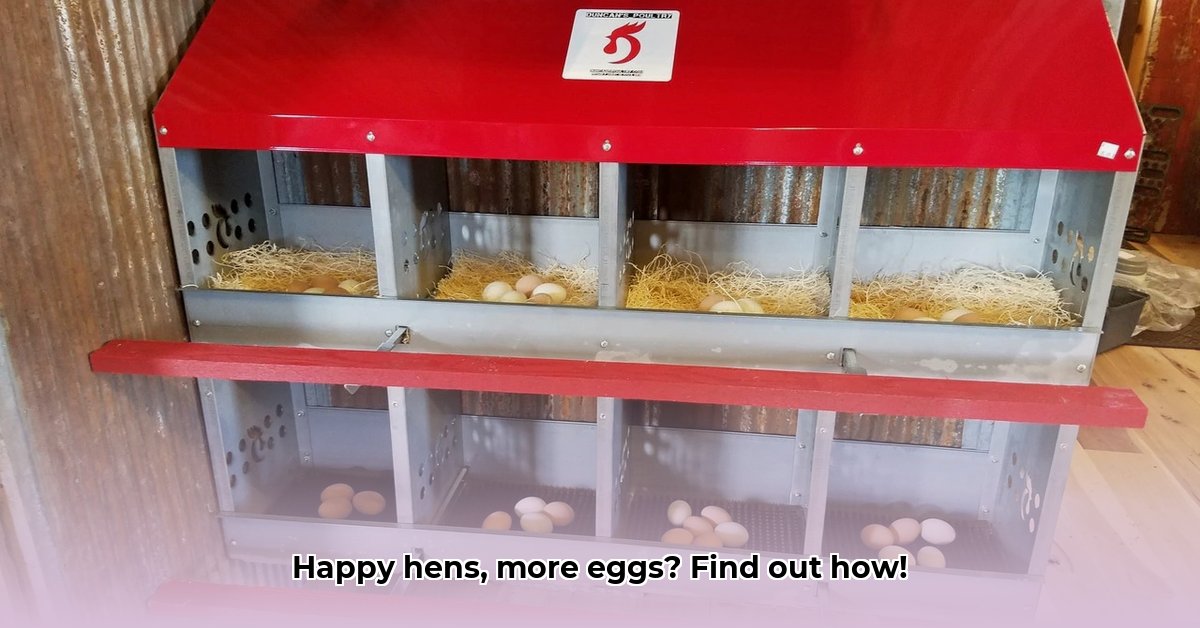
Getting your hens to lay more eggs is easier than you think! A crucial element is providing comfortable nesting boxes. This guide covers choosing, building, or buying the perfect nest boxes, no matter your experience level. For more coop ideas, check out this resource. Let's create the ideal nesting environment for your flock.
Choosing the Right Nest Box: Size and Materials
The ideal nesting box size isn't one-size-fits-all. Larger breeds like Orpingtons need more room (consider 15" x 15" x 12") than smaller breeds like Bantam hens (a minimum of 12" square is a good starting point). Too small, and hens will feel cramped and stressed, reducing egg production. Too large, and they might not feel secure enough to lay.
Material matters too. Wood is a classic, natural, and relatively inexpensive option. It's easy to maintain and can even be upcycled from old pallets (ensure it's treated with a chicken-safe sealant). Plastic offers durability, easy cleaning, and pest resistance, but can be more expensive. Tractor Supply offers both types. Good ventilation is key for a fresh, mold-free nesting area. A stuffy box is a breeding ground for bacteria.
Building or Buying: DIY vs. Pre-Made
Are you a DIY enthusiast? Building your own nest boxes gives you full customization control and may save money. However, building involves time, effort, and basic carpentry skills.
Alternatively, Tractor Supply provides pre-made options for convenience and a time-saving approach. They are ready to use, eliminating construction time. The best option depends on your skills, time constraints, and budget.
| Option | Pros | Cons |
|---|---|---|
| DIY | Customizable, potentially cost-effective, satisfying project | Time-consuming, requires skills and tools, potential for error |
| Pre-made | Convenient, quick setup, ready to use | Less customization, may be more expensive |
Nest Box Placement: Privacy and Accessibility
Strategic placement is vital for encouraging egg laying. Hens prefer dark, quiet, secluded areas. A corner of the coop, away from drafts and direct sunlight, is ideal. Avoid high-traffic areas to minimize stress.
For multiple hens, having enough boxes prevents competition. Aim for at least one box per three to four hens, but adjust based on your flock size and hen personalities. Space boxes evenly for fair access. Do you need even more boxes to ensure optimal egg-laying?
Maintenance and Cleaning: Hygiene and Prevention
Regular cleaning keeps the nesting area hygienic and prevents disease. Spot-clean daily, perform a thorough cleaning weekly, and a deep clean monthly, using a chicken-safe disinfectant. Replacing nesting material regularly also contributes to a healthier environment – keeping the nest boxes clean isn't just about hygiene; it also leads to happier hens and, indirectly, to more egg production.
Troubleshooting: Common Issues and Solutions
Even with careful planning, problems may arise. Here are common issues and solutions:
- Hens roosting in boxes: Add more perches outside the boxes to give them alternative resting spots.
- Egg breakage: Use soft nesting material and add a slight incline to the box base for better egg protection.
- Hens avoiding boxes: Encourage use by placing fake eggs and providing tasty treats.
Key Considerations for Sustainable Egg Production
Three pivotal points regarding successful chicken nesting box management:
- Proper box size directly correlates with hen comfort and egg-laying frequency.
- Durable, easily cleanable materials contribute to both hygiene and the longevity of the nesting boxes.
- Strategic placement and regular maintenance are crucial for maximizing egg production and minimizing health risks.
By following these guidelines and providing comfortable, well-maintained nesting boxes from Tractor Supply or your own DIY efforts, you'll create an optimal environment for your hens to thrive and lay more eggs! Regular observation will give you the most accurate perspective on individual hen behaviours and what works best for YOUR flock.